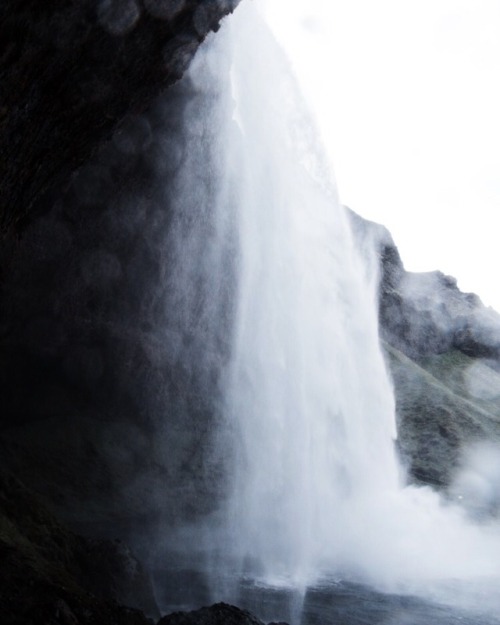#jotunn
3.5 Had stats for the Frost Jotunn from Norse mythology so I made some stats and a video on them if you’d like to check that out.
Channel: https://www.youtube.com/channel/UCPcFsxfrenLv_Nx0oxSmBhA
Post link
Check out my newest video on the Bog Giant, creatures from the swamp.
Channel: https://www.youtube.com/channel/UCPcFsxfrenLv_Nx0oxSmBhA
Post link
Did a rough animation of the Sand giant, the topic for todays video. Keep on the look out for it later today on my youtube.
https://www.youtube.com/channel/UCPcFsxfrenLv_Nx0oxSmBhA
Post link
In the Norse creation mythology, the worlds were created mainly through the clashing of fire and ice, heat and moisture. Among the first beings in existence were the fire giant/deity Surtr, the hrimthurs (ice giant/deity) Ymir, and the giant nourishing cow Audhumla. From heat and moisture on his body, Ymir begat other beings, and they in turn produced their own offspring. Odin was closely descended from Ymir on his mother’s side, and Odin’s paternal grandfather, Buri, was considered the first god. Buri had been different from Ymir’s creations in that he had been created from the cow Audhumla’s licking of a block of ice (creation was again achieved through a meeting of heat and ice).

Odin and his immediate family, although partially descended from Ymir, considered themselves set apart from Ymir’s creations, dubbed the Jotnar. Odin and his brothers saw Ymir as an enemy, and, fearing his immense power, they caught him unaware and slew him.

Ymir had been an enormous being, so his death did not come without collateral damage. The blood that poured from Ymir’s body created a flood that killed Odin’s parents and all the Jotnar but one, Bergelmir (also known as Farbauti). It is generally believed that the longstanding feud between the Aesir and Jotnar arose from this near destruction of all Jotnar and complete destruction of Ymir, as committed by the Aesir, and the ultimate battle of Ragnarok was to be the Jotnar’s revenge for the act.
Bergelmir and his wife had taken refuge on a small wooden boat, and thus escaped from the treacherous fate that befell the rest of the Jotunnar. It is unclear whether Bergelmir’s wife Nal (also known as Laufey) was Jotunn or god (As). Bergelmir is said by some sources to have been the only remaining Jotunn, but in other sources his wife is included with him (although this may have simply been an assumption made because it was a Jotunn to whom Nal was wed). Whatever Nal’s ancestry though, it was the union of Bergelmir and Nal that repopulated the world’s tree with Jotnar once more. The land to which they escaped became Jotunnheimr.
Among Bergelmir (or Farbauti) and Nal (or Laufey)’s offspring was Loki. The myth concerning the conception of Loki states that Loki was born from Bergelmir (or Farbauti) striking Nal (or Laufey) with lightning. Loki was originally a fire deity before he became more closely associated with the trickster archetype, and this better explains the odd story of conception. Farbauti, meaning “fierce strike”, was a representation of lightning. Nal meant “pine needles”, and her other name, Laufey, meant “leaves”. In this way, Loki – fire – was created by Farbauti – lightning – striking Nal or Laufey – pine needles or leaves. The story describes a natural phenomenon with representative personifications.
A farmer entered into a game of chess with the Jotunn Skrymsli, and if the Jotunn won, the farmer had promised his only son as payment. Skrymsli ultimately did win, and announced he would come the next day to collect his prize. If the boy was hidden so cleverly that Skrymsli could not find him, then he would allow the farmer to keep his son. Not wishing to lose their son, the farmer and his wife appealed to Odin, Hoenir, and Loki for help.
Odin caused a great cornfield to grow up overnight, and he hid the farmer’s son in a single kernel of one ear of corn in the middle of the vast field. When Skrymsli arrived, he ploughed through the field, harvesting every single ear of corn in his search. He finally grabbed the ear in which Rogner dwelt, and Rogner cried out in fear, alerting the Jotunn to his presence. Odin snatched Rogner from harm’s way, and Skrymsli resolved to return the next day for his payment.
Hoenir was next to attempt to hide the farmer’s son. He changed the boy to a feather, and hid him on the breast of a swan. Skrymsli came again the next day, searching diligently, and, on noticing a feather out of place on a swan, once again located his prize. Before the boy could be seized though, Hoenir caused a gust of wind to carry the feather away to safety. Skrymsli went home without his prize a second time.
Finally, it was Loki’s turn to hide the boy. He stole away with the boy during the night, taking him out onto the ocean in a small boat. Loki pulled several fish from the ocean and tossed them back until he found a female flounder. He then proceeded to hide the farmer’s son as a tiny egg in the roe of the flounder, and he tossed the fish back into the ocean. Unfortunately, when Skrymsli came the next day, he discovered Loki returning to the shore, so he set on the sea with his own boat. Loki insisted on accompanying Skrymsli, since he wanted to be nearby if the farmer’s son was in need of further protection. Skrymsli pulled up several fish, and eventually pulled up the very fish on which Loki’s charge was hidden. Loki feigned hunger at that point, and asked Skrymsli if he could eat of his catch. It did not need to be a great amount of food – even the tiniest fish (on which the farmer’s son was hidden) would do.
Skrymsli ignored Loki and continued searching among the fish in his catch. Finally, he located the boy, but before Skrymsli could claim the child for his own, Loki snatched the boy away and flew him to the mainland. Loki had also failed in hiding the boy from Skrymsli, but he was not willing to be defeated. He instructed the boy to run away, and to be sure to run through the boathouse on his way home. Skrymsli returned to land quickly and gave chase, following the boy across the land and through the boathouse. In the boathouse, however, Loki had set a sharp spike in such a position that it would pierce Skrymsli’s skull as he ran through. Loki’s trap succeeded, and Skrymsli fell to the ground defeated, but not killed.
Loki then cut off Skrymsli’s legs, but the legs reattached to the body afterward through magic. Loki cut the legs off once more, and this time branded the severed areas with hot metal to cauterise and seal the wound. With the wounds sealed, they could no longer reattach themselves. Skrymsli eventually succumbed to his wounds and died. The boy returned to his parents, finally safe from the Jotunn Skrymsli, and the family was so grateful that they thereafter honoured Loki above the other gods.
One day, while borrowing Freyja’s falcon cloak Valsharmr, Loki came upon the jotunn Geirrodr’s expansive castle. Unfortunately, Loki was spotted, and seized before he could escape.

Geirrodr demanded to know who he was, and why he was spying on him, but Loki remained silent. Geirrodr had a famous hatred for Thor, so as Thor’s best friend, Loki was sure his true identity should remain hidden, at least if he valued his life.
When Geirrodr did not receive an answer though, he imprisoned Loki, denying him food, drink, and sunlight. Loki endured for three months before he started to think he could take no more of the torture. He called for Geirrodr and begged to be released, promising to do or say anything the jotunn desired. On learning that his prisoner was Loki, Geirrodr agreed to release him, provided that Loki brought Thor to Geirrodr’s castle, without his hammer, the gloves required to carry the hammer, or the girdle Megingardr, which increased Thor’s already prominent strength. Loki agreed, and was allowed to return to Asgard.
On returning, he set about enticing Thor to travel with him to Geirrodr’s castle. However, Loki stipulated, Geirrodr did not want Thor dining in his hall with his hammer, gloves, and girdle of strength, since Thor could easily disrupt the party and kill him instead. Thor was not enthusiastic at the prospect, but Loki assured him Geirrodr would feed and house them well, and that Geirrodr’s two daughters, Gjalp and Greip, were stunning to behold. Trusting Loki’s judgement, Thor finally agreed to go.
On the way, Loki and Thor spent a night at the home of one of Odin’s past mistresses, the jotunn Gridr. When Gridr heard that Thor was journeying to Geirrodr for a feast without his battle accessories, she assured Thor that he had been deceived. Geirrodr was a fierce enemy of Thor, and was intent on killing him. Thor was outmatched without his weapon, but if Thor did not go to Geirrodr, Loki would be captured, tortured, and possibly killed for failing to keep his promise. Thor did not want such a thing, so he resolved to kill Geirrodr himself. He asked Gridr to borrow her girdle of strength and iron gloves, and also her magic staff Gridarvolr. Gridr agreed, and sent Thor and Loki on their way.
The two attempted to cross the river Vimur to reach their destination, but the river grew fierce, and Loki was forced to cling to Thor to keep from being washed away. Wondering why the river was behaving thusly, Thor looked upstream, and saw that Geirrodr’s daughter Gjalp was adding liquid to the river, causing the water to rise significantly.
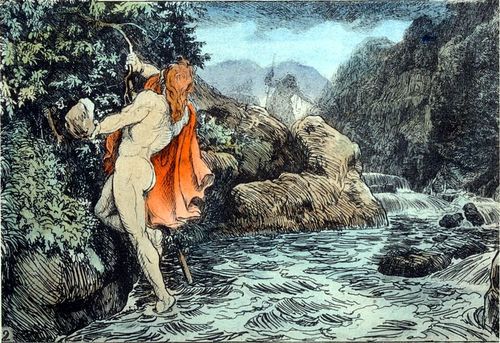
Thor threw a rock at the jotunn to stem the river flow. He pulled himself and Loki out with the branch of a rowan tree, and they finished making their way to the home of Geirrodr.
Thor and Loki were led to a room with a single chair, and Thor seated himself. Suddenly, the chair began rising toward the roof, threatening to crush Thor against it. Thor acted quickly and used Gridr’s unbreakable staff to push himself away from the roof. This sudden action caused the two jotnar pushing his chair to the ceiling, Gjalp and Greip, to break their backs and fall to the floor.
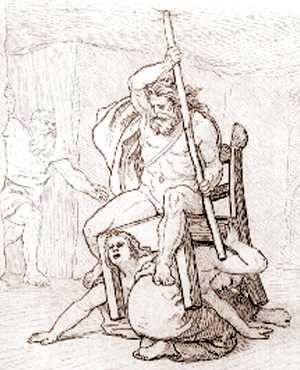
It was then that Geirrodr entered, and took hot iron from a fire with tongs. He threw it directly at Thor, but Thor easily caught the projectile in the iron gloves he wore. Realising the danger he was in, Geirrodr hid himself behind a pillar, but Thor threw the molten iron back at Geirrodr, and it crashed through the pillar to pierce and kill Geirrodr.
Some versions of the myth include Thjalfi in Loki’s place, or Thjalfi making the journey with both Thor and Loki, but his involvement is uncertain, because he does little that is noteworthy in this myth.
A Jotunn called Rasvalg once caused a great deal of trouble for Midgard. In the form of an eagle, he fanned great gusts of wind across the land, causing plants, animals, and men to die. Loki and Thor resolved to put an end to this mischief, and set out for Jotunnheimr in Thor’s goat-drawn chariot. While passing through Midgard, they stopped to rest one night in the home of a poor farmer with a wife and two children. The family did not have enough food to properly accommodate their guests, so Thor slaughtered his two goats to feed the group. Thor asked that the bones be laid on the skins when the meal was finished, and that no one break the bones.
Sensing an opportunity for mischief, Loki suggested to the farmer’s son, Tjalfe, that he should break open the bone to eat the marrow inside, reasoning that it was the best part, and contained magical properties. Tjalfe agreed with Loki’s logic, and did as was suggested. In the morning, Thor resurrected his two goats from their bones and skin, using his hammer. But one of the goats was lame, because of Tjalfe’s actions.

Thor was furious at the insubordination, but the father eventually managed to quell Thor’s temper by offering his two children, Tjalfe and Roskva, as servants. They would accompany Thor and Loki to Jotunnheimr, and the group would return after their mission to retrieve Thor’s two goats.
They set off once more, and that night they found a cave that contained five different passages. Startled by roaring sounds outside, they hid themselves in the back of the smallest passage and stayed there for the night. When they awoke and emerged from the cave, they found that the sound had been the snoring of a giant Jotunn, and the passage of what they thought was a cave was actually the thumb of the giant’s glove. The giant introduced himself as Skrymir, and offered to accompany the group. He took it upon himself to carry their provisions, but the giant’s strides were so long that the group could not stop to rest at all, and they were not able to eat all that day.
When Skrymir finally stopped to sleep for the night, the group was famished. They attempted to open the bag to their provisions, but they could not untie the knots with which the giant had sealed it. Even Thor’s immense strength was no match. Frustrated, Thor attempted to wake Skrymir, but the task seemed impossible. Thor threw his hammer three times at the giant’s head, each time with more force than the last. But Skrymir only mumbled that a leaf or an acorn must have fallen on him, and he promptly returned to sleeping each time.

They set out again the next day, and Skrymir announced that he was going on ahead, and they quickly lost sight of him. Eventually, Thor, Loki, and Tjalfe arrived at the castle of the Jotunn Utgarda-Loki (no relation to Loki). The group proceeded to attempt a series of contests, in order to prove themselves worthy of staying at the castle. Loki, hungry from losing his provisions to Skrymir, offered that he could eat more than any Jotunn there, and thus, an eating contest was begun. Loki and his opponent Logi began eating at opposite ends of a trough, and they both reached the exact middle at the same time. However, Loki had only eaten the food, while Logi had eaten the food, the bones, the dishes, and the trough, so Loki lost.
Tjalfe fancied himself to be a swift runner, so he competed against one called Hugi in a footrace. Although Tjalfe was indeed faster than most, he too was defeated by his opponent. Thor then asserted that he could drain a drinking horn, and so a horn was provided for him. Thor drank until he was about to burst, but could only lower the level by a small amount. It was then suggested that Thor lift Utgarda-Loki’s cat, but in this task Thor could only lift one paw. Finally, a feeble, elderly woman named Elli was called out to wrestle with Thor, and in this task too Thor was defeated.

Utgarda-Loki escorted the three humbled guests out of his castle, and once they were outside, he revealed to them that they had been tricked. Fearing the strength of his visitors, Utgarda-Loki had disguised himself as Skrymir, and he had tied up their food so they would be weak with hunger when they arrived at his castle. When Thor had attempted to strike Skrymir’s skull with his hammer, the hammer blows instead had fallen on a nearby mountain, and the force of the blows had created three deep valleys. If any one of the blows had struck Utgarda-Loki, he would have died.
Loki’s eating contest had been against fire, which consumes everything in its path, so it was incredible that Loki was able to perform as well as he had against the flame. Tjalfe’s footrace had been against thought, which works quicker than anyone can run. Thor’s drinking horn had been attached to the sea itself, and Thor had actually managed to lower the level of Midgard’s oceans with the amount he drank. The cat Thor was tasked with lifting was in fact Jormungandr, the Midgard serpent so large it encircled the world, so lifting its paw was an incredible feat of strength. Finally, the old woman had been old age itself, and old age eventually brings everyone, even gods, to their knees. That Thor had lasted as long as he did was better than anyone could have achieved.
Utgarda-Loki apologised for the trickery, but confessed that he was right to do so, because the strength of the group was terrifying, and he could never have beaten them through honest means. Thor raised his hammer, frustrated that he had been made to look a fool, but before he could attack, both Utgarda-Loki and his castle had disappeared. Tjalfe and Roskva returned with Loki and Thor, and served Thor from then on.
In early Norse mythology, before the Aesir became a more prominent force, Loki was more closely related to fire and hearth, and to weather. His name was also very similar in pronunciation to the Jotunn fire spirit Loge, further casting him in that role. Presumably before he had met Odin, Loki lived in Jotunheimr with a wife called Glut (Glow) and their two daughters Eisa (Ember) and Einmyria (Ashes).
When waves of heat could be observed as rising from the ground, it was said that Loki was sowing his oats. When moisture evaporated, it was attributed to Loki collecting the moisture to make a drink. Among the Nordic people, when flames crackled on the hearth, it was said that Loki was beating his children. When rain fell despite the sun being out, it was said that Glut was weeping.
As stories of the gods of Asgard began to gain popularity, Loki’s role soon progressed to one of the Aesir. Loki left his old life behind and moved to Asgard, where he was at some point associated with a new wife, the Aesir Sigyn.
Thjassi, the Jotunn who had kidnapped Idunn, was killed by the Aesir while he was pursuing Loki, who had retrieved Idunn from his home. Hearing news of this, Thjassi’s daughter Skadi journeyed to Asgard. She demanded retribution for the death of her father, and threatened destruction if they did not appease her. Thjassi’s two brothers were just as mighty as he, and Skadi assured them that they would be happy to attack Asgard if the Aesir did not pay for Thjassi’s death.
The Aesir desired for peace, so they offered Skadi any amount of their gold. Skadi flatly refused, since she had more gold than all of Asgard could even comprehend. She demanded that the gods offer a more suitable gift, and because of her issue with the first offer, Skadi also demanded that they make her laugh. The gods were at a loss, when finally Loki came forward with an idea. They would give Skadi a husband from among them, and the results would be twofold; Skadi would be appeased, and she would also become an ally to Asgard. It was a brilliant plan, and the gods immediately offered Skadi a husband.
Skadi agreed readily, and announced that she chose Baldr, most handsome of all the Aesir and son of Odin. The gods quickly stipulated that this was not how her husband would be chosen. Each of the male gods was to stand behind a screen, and Skadi would choose her husband by his feet. If she chose Baldr’s feet, then the god would indeed be hers.

Skadi located the most beautiful feet among those assembled, assuming they belonged to Baldr, and declared that this was to be her husband. It was revealed that the feet belonged to the Vanir hostage Njordr, father of Freya and Freyr. Njordr was a god of the sea, and spent most of his time by the ocean. As a result, his feet were smooth and beautiful.
A wedding ceremony was held, and during the subsequent feast, Loki had a goat brought into the hall, along with a rope. One end of the rope was tied to the goat’s beard. Then Loki removed his clothes and tied the other end of the rope to his testicles. The goat proceeded to leap about, yanking Loki around the room howling in pain. Loki fell into Skadi’s lap, and Skadi laughed at his antics. Thus Loki had fulfilled the agreement to make Skadi laugh.
Odin also thrust Thjassi’s eyes into the sky, where they became two stars. Skadi was satisfied, because this was an honour to her father. Skadi gained status as one of the gods, and she was appealed to by those in Midgard as goddess of the hunt, for her skill with bow and arrow. She was also appealed to for help in winter with skis, sleighs, and snow shoes, and also with mountains.

The success in appeasing Skadi and gaining her as an ally was due mostly to Loki’s craftiness, and also his willingness to endure great pain for the benefit of Asgard.
By the time the war between the Aesir and Vanir had ended, Asgard’s walls had sustained significant damage. With the defences as they were, Asgard was vulnerable to attack by any of its enemies, most notably the Jotunn. It was at this time that a man arrived, seated atop a fine white stallion, who volunteered to rebuild the shattered walls. He boasted that his walls would be the strongest in all the world’s tree.
Such a claim would not be easy to accomplish, and the gods feared such a task would not be easy to afford either. On asking, they found the man's price was Freya’s hand in marriage, the sun, and the moon. It was an outrageous demand. Furthermore, Freya was one of the Vanir hostages, living with the Aesir as per the terms of the recent war’s treaty. Handing one of the hostages off to an unnamed stranger was not likely to promote good relations with the Vanir.
But Loki, skilled in avoiding payment (especially to the dwarves who had built Mjolnir), introduced a shrewd plan to the Aesir. They would limit the man to only three years, and the man would not be allowed any help. If the man did not finish the wall in those three years, as was surely impossible anyway, he would have failed to keep his end of the bargain, so the gods would not be required to pay. Even if the walls were not completely rebuilt, to have even a small portion rebuilt for free was ideal.
When presented with the terms of this agreement, the man agreed, on the condition that he be allowed the use of his horse, Svadilfari. The gods were initially confident that they would gain a wall for free, but in the months during which the wall was being built, it soon became apparent that they had been wrong to make such a deal. With the help of Svadilfari, the man was completing the walls at an alarming rate, and it was clear he would indeed be finished within the three year limit.
The gods were unwilling to part with Freya, the sun, and the moon, so they demanded that Loki find a solution for them to avoid payment. The plan had originally been Loki’s, even if the other gods had agreed to it, so Loki was the one blamed for the situation. If he did not find them a way out of the deal, the gods threatened, Loki would be tortured and killed under the brunt of their rage. Furthermore, the Aesir had an image to maintain, so whatever solution Loki employed, it had to be one that maintained the farce that the gods were treating the deal fairly.
Killing the mason or his horse, or worming out of the deal with words and loopholes would only make the gods appear dishonourable, so Loki was limited in what he could do. But Loki’s cunning had never met an obstacle it could not overcome. He took the form of a mare to draw the man’s horse away from the construction. On seeing the beautiful mare, the stallion Svadilfari immediately reared up, broke free from the cart to which he was attached, and ran off after the mare.
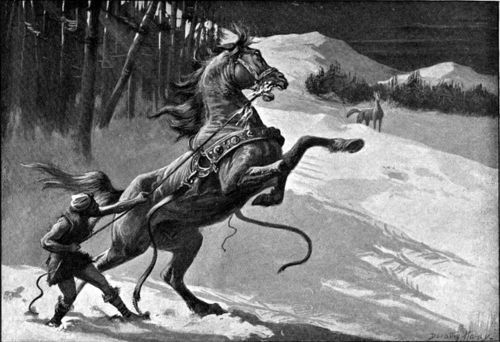
The mason searched for his horse all night, but to no avail. He eventually returned to the wall, attempting to complete the task himself. But without his horse, he could not complete the wall in time. The gods informed the mason that since he had not completed the task, he would not be paid. The man had been foiled by his own horse’s lust, so there was no way he could blame the gods for breaking the deal.
The gods attempted to dismiss the man without his pay, but the man was frustrated at his loss. He revealed himself to be a Jotunn in disguise, and began to smash up all he could in his rage. Surrounded by gods though, he was ultimately defeated by Thor’s hammer Mjolnir. Loki returned some time later, having produced a foal by the stallion Svadilfari. He named the foal Sleipnir, and presented it as a gift to Odin. The foal had eight legs, and grew to be the fastest and best horse in all the world’s tree. It was a very fine gift.
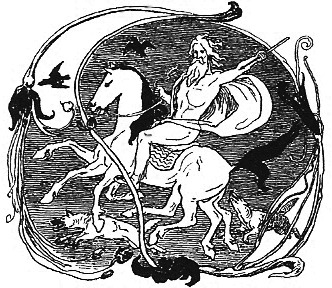
Loki had thus acquired the strongest of fortifications for Asgard for no pay at all, and he had produced for Odin the fastest horse in the realm. Although Loki had given the gods a scare when his original plan had seemed doomed to fail, he was never to be bested by troubles, and he always redeemed his mistakes to the benefit of Asgard.
The Jotunn were the chief enemies of the gods, but it was, for the most part, in a political sense. Jotunn are often characterised as vicious beasts on a rampage, whose destruction is celebrated as a noble deed. The distinction between god and Jotunn was not so black and white.
Jotunn were, in fact, very similar to the Aesir themselves. Some possessed great strength, some magical powers, and some intellect. Some favoured a more hostile approach to dealing with the gods, some simply kept to themselves, and others were hospitable and even helpful to the Aesir. Attitudes varied depending on the individual, and depending on how the gods had treated him in the past. The only real difference between Jotunn and god seemed to be in appearance. Some Jotunn looked just like the gods, and could be described as beautiful, but most often Jotunn were described as ugly, dirty, and monstrous in appearance. Some had extra limbs, or even multiple heads.
Appearance seemed to vary a great deal between one Jotunn and another, but a displeasing appearance was fairly common, and while a fair appearance would often endear a Jotunn to the gods, a monstrous one would invite hostility. Disagreements between Jotunn and Aesir as a whole seemed to be, most often, individuals squabbling over resources. There was a deeper underlying hatred though, that persisted throughout time despite dealings with completely pleasant Jotunn. There were indeed many wicked Jotunn, and unfortunately it may have been they that gained the hatred of the Aesir for their entire race.
Loki was a Jotunn who had been invited to live in Asgard, and he was described as one of the beautiful Jotunn, similar in appearance to the gods. But Loki was not the only Jotunn whom they valued. The Jotunn Skadi also became one of the Aesir, and married with the Vanir Njordr. Freyr fell hopelessly in love with the Jotunn Gerdr, and essentially blackmailed her into marrying him. Thor himself was born by Odin and the Jotunn called Jord. Odin produced many other children by various Jotunn mistresses. Thor also took a Jotunn mistress at one point, Jarnsaxa, and by her produced his son Magni, who famously rescued Thor when he had been trapped under a fallen Jotunn’s foot. The Jotunn Gridr, mother of Vidarr, housed Thor and Loki when they were travelling past her home, and helped equip Thor for a battle he had been tricked into attending without any weapons or armour.
Many considerations of Loki’s heritage as a Jotunn conclude that Loki is inherently evil because of his race. Such an assumption is often made because Loki’s motives behind his rampant mischievousness are often difficult to understand (this will be addressed in detail in a later post), and it is much easier to simply decide he is evil because he is Jotunn. This, however, makes very little sense. Thor, the champion of the gods, was also born of a Jotunn mother. It is better to realise that all individuals, be they Aesir, Vanir, Jotunn, Alf, Dvergue, or something in between, choose their own lives, and cannot be judged based on race.
Angrboda was a Jotunn witch who sowed seeds of discord wherever she went. She was responsible for provoking the lust for gold, and cheating and murders in Midgard. Acting on behalf of the Jotunns who desired to destroy the Aesir and Vanir, she had used her trickery to create a vast divide between the two. She was eventually discovered and burned for her actions, but she was not so easily destroyed. Her body burned away, but her heart did not. From these remains, Angrboda was able to resurrect herself in entirety. As long as her heart was intact, she could continue to revivify.
The executors promptly attempted to burn the witch a second and third time, but each time, she resurrected, burned, and the heart remained. Loki saw that this game would go on forever if they did not dispose of the heart, so before Angrboda could resurrect again, Loki rushed forward, pulled the heart from the flames, and swallowed it.

But even with that, Angrboda’s evil was not completely destroyed. From the heart he had swallowed, Loki gave birth to three beings: Fenriswulf, Midgardsormr (or Jormungandr, as it was called by the Jotunn), and Hela. Fenriswulf, a large grey wolf, would go on to bite off the hand of the battle god Tyr, herald the beginning of Ragnarok by escaping his bonds, and destroy Odin in the final battle. Midgardrsormr was a serpent who would grow so large he encircled the world, and in the final battle he would destroy the mighty Thor. Hela, a normal woman on one half of her body and a corpse on the other, was the only one of the three who was not destined for evil. She would go on to become caretaker for the dead who were not killed gloriously in battle, in the realm of Niflheim.

Angrboda’s evil also persisted in the tension she had introduced between the Aesir and Vanir. Despite her death, her actions still resulted in a war between the two. In this way, Angrboda had succeeded.
When Odin and Loki first met, they took an instant liking to one another. Odin was fond of knowledge and resourcefulness wherever he found it, and Loki possessed that in spades. Loki too valued these qualities, and saw them in Odin.
Since the two were so fond of one another, it came to be that, at some point early on, they swore a blood oath. Though it is unclear how Odin and Loki met, their swearing of a blood oath may indicate that it was the result of the two fighting as allies in battle, against some common enemy.
A blood oath consists of the two individuals each slashing one of his hands, and pressing it to that of the other, and thus they become blood brothers. After their oath, Odin presumably invited Loki to visit or live in his realm of Asgard as one of the Aesir, because following their meeting, Loki lived among his fellow Aesir in Asgard. It was always Asgard to which Loki returned, and mostoften Asgard to which he was loyal.
Loki is of Jotunn heritage, being born from the union of two Jotunns: Farbauti, his father, and Laufey, his mother. Although one’s surname was typically taken from the father’s given name, Loki is unique in that he is called by his mother’s name, Laufeyson.
There is a possibility that Loki’s mother Laufey was actually one of the Aesir, and this would be adequate reason for Loki to refer to his mother’s heritage rather than his father, given that Loki lives among the Aesir.

Letting me customize my character was a big mistake …
(on the other hand, what else could you expect from me)
Hræsvelgr
“Hræsvelgr he is called,
who at the end of heaven sits,
a Jötun in an eagle´s plumage:
from his wings comes,
it is said, the wind,
that over all men passes.”
- Vafþrúðnismál
Photograph by Grete Øiamo
Post link

A jotunn, sometimes anglicized as jotun (pronounced yotun), is a giant in Norse mythology, a member of a race of nature spirits with superhuman strength, described as sometimes standing in opposition to the races of the tribles of the Aesir and Vanir, although they frequently mingle with or intermarry with these. In some legends and myths they are described as having the same height as humans. In later Scandinavian folklore, the nature spirits called trolls (deriving form the term for ‘magic’) take over many of the functions of the more ancient concept of the jotunn. The mountain range of southern Norway is likewise called in Norwegian Jotunheimen or the Jotunheim Mountains.
ORIGINS:
The first living being formed in the primeval chaos known as Ginnungagap was a giant of monumental size, called Ymir. When he slept a giant son and a giantess daughter grew from his armpits, and his two feet procreated and gave birth to a monster with heads. Supposedly, these three beings gave rise to the race of hrimpursar (rime giants or frost giants), who populated niflheim, the world of mist, chill and ice. The gods instead claim their origin from a certain Buri. When the giant Ymir subsequently was slain by Odin, Vili and Ve (the grandsons of Buri), his blood (i.e. water) deluged Niflheim and killed all of the giants, apart from one known as Bergelmir and his spouse, who then repopulated their kind.
APPEARANCE AND CHARACTER:
Some of the giants are attributed with hideous appearances– claws, fangs, and deformed features apart from a generally hideous size. Some of them may even have many heads, such as Thrivvaldi who had nine of them, or an overall non-humanoid shape; so were Jormungandr and Fenrir, two of the children of Loki, viewed as giants. yet when giants are named and more closely described, they are often given the opposite characteristics. Very old, they carry wisdom from bygone times. It is the giants Mimir and Vafpruonir Odin seeks out to gain this pro-cosmic knowledge. Many of the gods’ spouses are giants. Njord is married to Skaoi, Geror becomes the consort of Frey, Odin gains the love of Gunnlod, and even Thor, the great slayer of their kind, produces a child with Jarnsaxa; Magni. As such, they appear as minor gods themselves, which can also be said about the sea giant Aegir, far more connected to the gods than to the other giants occupying Jotunheim. None of these fear light, and in comfort their homes do not differ greatly from those of the gods.
DIFFERENT KINDS OF GIANTS:
Frost Giants: Said to live in the coldest parts of the world and Jotunheimr. There are many Norse tales and legends that speak of frost giants catching unsuspecting travelers by luring them to sleep in the cold by whispering sweet words and lullabies when they become too exhausted to carry on. They mostly populated Niflheimr.
Fire Giants: Said to live in the lower parts of Jotunheimr where it is warm and has a scattering of volcanoes. During Ragnarok it is said that the fire giants will ride on great horses and burn Nidgard killing all the people, some of the gods, and all the fire giants themselves except a man and a woman sent by Odin in a great forest that was not destroyed by the chaos and flames.
Small installment, but there’s a Casablanca quote which I couldn’t resist but adding.
It was there.
It was looking at me.
And now it’s up on Webtoon!
Play As Time Goes By, but play it on Webtoon! (Click here!)
Till Queendom Come is a project about an Indian Rakshasi who’s trying to find her lost heart after the East India Company stole it, a Jotunn who didn’t feel like going back to Norway after the Vikings invasions, and the young nephew of the last druid of St. Ives who’s now trying to keep on the family tradition on her own in spite of being the wrong gender to do so.
Started as a project set in Edwardian England, born in a urge of sudden irritation about seeing Victoria being romanticised everywhere by a cynical comic artist who majored in English. You can read it on Instagram under the hashtag #oscarpoppins (which was its unofficial title until now and in my mind will always be), or on Webtoon.
Post link
Take me down to the Paradise city
When the Thames is green and the Jotunn’s pretty
New episode on Webtoon! (Click here!)
Till Queendom Come is a project about an Indian Rakshasi who’s trying to find her lost heart after the East India Company stole it, a Jotunn who didn’t feel like going back to Norway after the Vikings invasions, and the young nephew of the last druid of St. Ives who’s now trying to keep on the family tradition on her own in spite of being the wrong gender to do so.
Started as a project set in Edwardian England, born in a urge of sudden irritation about seeing Victoria being romanticised everywhere by a cynical comic artist who majored in English. You can read it on Instagram under the hashtag #oscarpoppins (which was its unofficial title until now and in my mind will always be), or on Webtoon.
Post link







